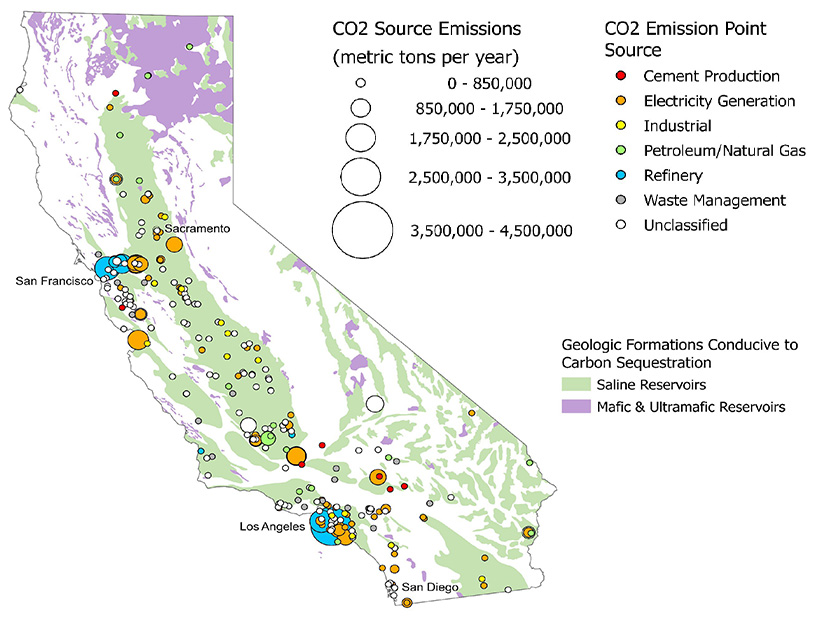
California regulators have started developing a program to manage carbon capture and storage projects in the state, as mandated by legislation passed last year.
Senate Bill 905 of 2022 directed the California Air Resources Board (CARB) to create a carbon capture, removal, use and storage program.
The program will regulate carbon capture: projects in which carbon dioxide is either captured from industrial or energy-related facilities or removed from the atmosphere. Storage involves injecting the captured CO2 into underground geologic reservoirs.
CARB kicked things off with two public meetings Aug. 15.
Under SB 905, CARB must create a streamlined permit application for carbon capture or storage projects by Jan. 1, 2025. CARB will also develop a database so the public can track the projects.
Other state agencies will be involved too. The California Natural Resources Agency (CNRA) will develop a framework for situations in which a CO2 storage reservoir lies beneath two or more parcels of land.
The framework, known as the Common Reservoir Operation Plan (CROP), will cover issues such as fair compensation for landowners and allocation of liability.
SB 905 requires the framework to be published by July 1, 2025; agency officials said they’re hoping to complete it a year sooner, by June 2024.
“Given the deadlines for other actions under SB 905, including CARB’s regulations, the framework will be more relevant and more supportive of other agencies’ actions if we do it sooner,” Lisa Halko, CNRA’s chief counsel, said during the Aug. 15 meeting.
Also under SB 905, the California Geological Survey has been tasked with identifying “high-quality, suitable locations” for CO2 injection wells.
Through its Geologic Carbon Sequestration Group, CGS will recommend monitoring techniques, such as plume tracking, to make sure the CO2 stays underground. The group will report earthquakes at storage sites or CO2 leaks to CARB, potentially with recommendations to change project operations.
Climate Package
The legislature passed SB 905 as a package with Assembly Bill 1279, which codified the state’s goal of achieving net-zero greenhouse gas emissions by 2045. (See Newsom Signs 40 Climate Bills.)
AB 1279 also set a target of reducing human generated GHG emissions by 85% compared to 1990 levels. It calls for maintaining net-negative GHG after the net-zero goal is met.
Carbon capture and sequestration (CCS) from industrial facilities and carbon dioxide removal (CDR) from the atmosphere both will be needed to achieve the AB 1279 goals, CARB concluded in its 2022 climate-change scoping plan.
Rajinder Sahota, CARB’s deputy executive officer for climate change and research, said the agency has long been aware of CCS — technology that is being used across the U.S. and Europe.
“But it wasn’t until very recently that all the scientists realized that the climate impacts are increasing at rates faster than we expected,” Sahota said during this month’s public meeting. “And so, in addition to reducing emissions, we also have to remove emissions. … That is what is called for by hundreds of scientists.”
Sahota said it’s critical to start deploying and scaling CCS and CDR technology this decade, to hit 2030 milestones on the way to the 2045 net-zero target.
As for the SB 905 requirements, Sahota said CARB plans to create a program portal to help with streamlining the permit process. CCS projects often need an array of permits, she said.
In addition, CARB must adopt protocols to support additional ways to store or use carbon dioxide, including carbon capture for use in products.
CARB already regulates carbon capture through its low carbon fuel standard; those regulations will be updated to meet SB 905 requirements, Sahota said.
Public Weighs In
One meeting attendee was Lorelei Oviatt, planning director for Kern County, where applications for several CCS projects are being processed. Oviatt said the geological survey might have a different view of site suitability compared to local government, which must consider issues such as setbacks and community concerns.
“Kern County has hundreds and hundreds and hundreds of acres that could be used, but they probably will not meet the local government’s requirements,” Oviatt said.
Another member of the public voiced concerns that SB 905 would open the door to widespread use of CCS.
“CCS projects must not be an end run around the primary statewide efforts to reduce and phase out fossil fuels,” she said.
According to the text of AB 1279, studies have found that CO2 removal methods and carbon capture, use and storage technologies are available, “but they do not negate the need to make drastic reductions in fossil fuel use.”
“Prioritizing direct emission reductions will help California to meet both its air quality standards and net zero greenhouse gas emissions,” the bill said.
